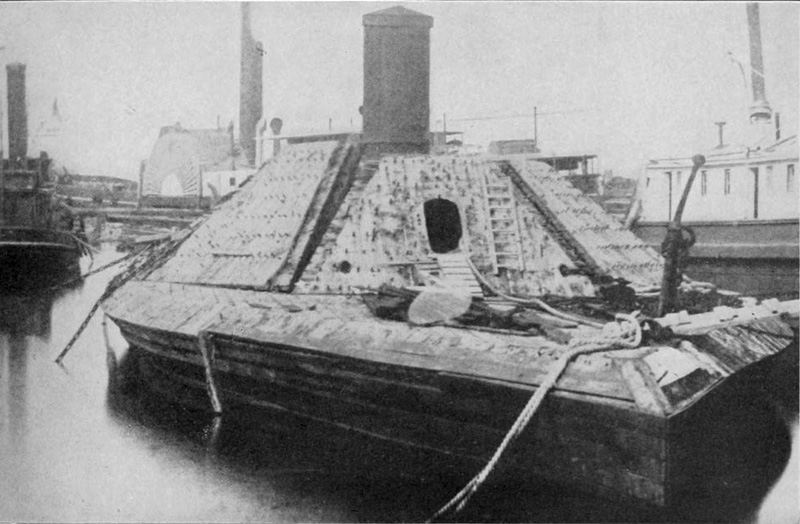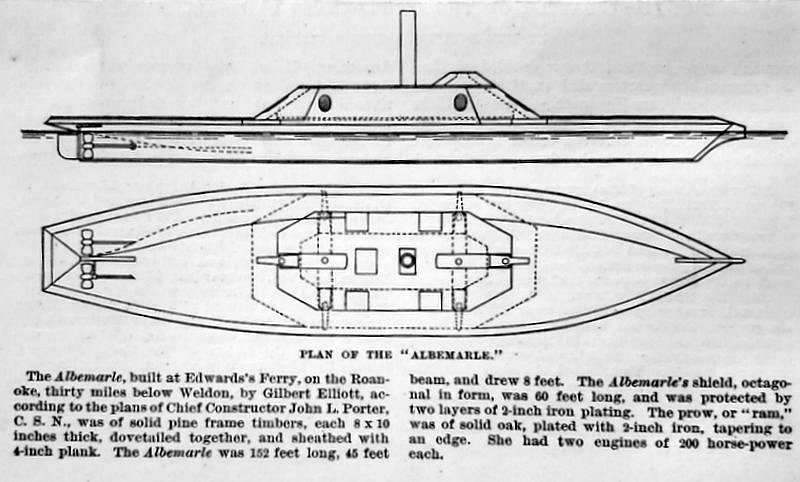|


256-bit encryption
$500,000 protection

|
CSS ALBEMARLE MODEL
The CSS Albemarle, an ironclad ram, was one of the
Confederacy's most successful ironclads. This vessel and
its sister ship, the CSS Neuse, were designed to wrest
control of North Carolina's sounds from the Federal
forces that had dominated the region since early 1862.

On 16 April 1862, the Confederate Navy Department,
enthusiastic about the offensive potential of armored
rams following the victory of their first ironclad ram CSS Virginia over
the wooden-hulled Union blockaders, signed a contract
with nineteen-year-old detached Confederate
Lieutenant Gilbert Elliott to oversee the construction
of a smaller but still powerful gunboat to destroy the
Union warships in the North Carolina sounds. These
men-of-war had enabled Union troops to hold strategic
positions that controlled eastern North Carolina.
Using detailed sketches provided by Elliott, the
Confederate Navy's Chief Constructor John L.
Porter finalized the gunboat's design, giving the ram an
armored casemate with eight sloping, 30-degree angle
sides. Within this thick-walled bunker were two 6.4-inch
Brooke pivot rifles (similar to a Parrott rifle), one
forward, the other aft, each capable of firing from
three different fixed positions. Each double-banded
cannon weighed more than 12,000 pounds with its pivot
carriage. Both cannons were protected on all sides
behind six exterior-mounted, heavy iron shutters.
The field of fire for both pivot rifles was 180-degrees,
from port to starboard: each cannon could fire from one
of three gun ports, allowing Albemarle to deliver a two
cannon broadside. Albemarle's projectiles consisted of
explosive shells, anti-personnel canister shot, grape
shot, and blunt-nosed, solid wrought iron "bolts" for
use against Union armored ships.
Construction of the new ironclad began in a cornfield at
Edward's Ferry on the Roanoke River in January 1863. To
ensure rapid completion of the Albemarle, the
Confederate navy sent its chief builder and designer of
the ship John L. Porter to oversee construction.
Abandoned railroad rails were scrounged from across the
state to be rolled into armor plates, and sawmills and a
blacksmith shop were established on site. The work was
aided by a newly developed drill that reduced the time
for drilling holes in the armor plate from 20 minutes to
4 minutes.
In late 1863 Cdr. James Cooke was sent to take over
Porter's supervision duties. Cooke, who would later
command the Albemarle in action, became known as the
"ironmonger captain" for his relentless efforts to
gather iron of all sorts that could be rolled into
plating.
By April 1864 the gunboat was nearing completion. The
ram was propelled by twin 3-bladed screw propellers
powered by two steam engines, each of 200 hp. Brig. Gen.
Robert F. Hoke was planning an infantry attack on the
town of Plymouth near the mouth of the Roanoke and
required the cooperation of the ironclad. Early on 17
April, as Hoke's infantry assaulted the outermost Union
positions, the Albemarle started out. Workmen swarmed
over its deck and casemate to fasten down the last layer
of armor even as it steamed downriver. The ship reached
Plymouth early on the morning of 19 Apr. 1864.
Waiting for it were the USS Miami and Southfield, the
most powerful of several wooden gunboats at Plymouth.
Chains had been strung between the two ships in an
attempt to ensnare the CSS Albemarle and batter it with
their combined fire. But Cooke recognized the trap and
avoided it. He then made for the Southfield, plunging
the ironclad's armored bow deep into the wooden vessel
and sinking it so quickly that the ram almost followed
the victim. The Miami, along with the other Union
gunboats, soon withdrew after shot and shell from its
6.4-inch rifles and 9-inch smoothbore guns glanced
harmlessly off the Albemarle's four inches of iron
plating. With the opposing fleet dispersed,
the Albemarle bombarded the last remaining strongholds
in Plymouth, helping force a Federal surrender.
Hoke next focused his attention on New Bern. The
ironclad Neuse had run aground en route to New Bern, and
so the CSS Albemarle was called upon to provide naval
support for the operation. On 5 May it steamed out of
Plymouth, but as the rebel ironclad reached Albemarle
Sound, 7 Federal gunboats mounting a total of 55 guns
attacked. The massed artillery of the fleet failed to
penetrate the armor, but the Albemarle's smokestack was
nearly destroyed and the muzzle of one gun was shot
away. In the melee the Albemarle itself was rammed by
one of the wooden gunboats. Its steering gear was
damaged, and, because of the mangled smokestack, it was
necessary to feed bacon, lard, and butter into the
boilers to keep up steam pressure. Despite having
damaged each of the Federal ships, Cooke had no choice
but to limp back to Plymouth.
The CSS Albemarle was repaired and remained at its mooring
until 27 Oct. 1864, when it was sunk by a torpedo in a
daring raid led by Lt. William Cushing. With their
ironclad gone, the Confederate forces evacuated Plymouth
on 31 October. In March 1865 the Union navy raised the
ship and towed it to Norfolk, Va., the following month.
The CSS Albemarle remained an officially commissioned U.S.
Navy ship until 15 Oct. 1867, when it was sold at
auction to J. N. Leonard and Company for $3,200.

We
build this primarily wood CSS Albemarle model in two sizes:
25" long
$2,290 Shipping and insurance
in the contiguous US included. Other places: $300
flat rate.
36" long
(1/48 scale) $3,125 Shipping and insurance
in the contiguous US included. Other places: $600
flat rate.
Models are made to
order only.
We require only a small deposit to start the
process $900
 The
remaining balance won't be due until the model is
completed, in less than 6 months. World's most
accurate model or 100% your money back. The
remaining balance won't be due until the model is
completed, in less than 6 months. World's most
accurate model or 100% your money back.
Learn more about the
Albemarle ironclad here:
https://en.wikipedia.org/wiki/CSS_Albemarle
|